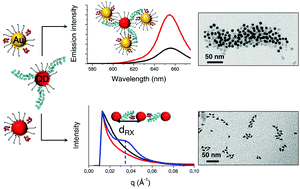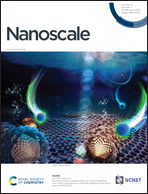Hybrid gold nanoparticle–quantum dot self-assembled nanostructures driven by complementary artificial proteins†
Abstract
Hybrid nanostructures are constructed by the direct coupling of fluorescent quantum dots and plasmonic gold nanoparticles. Self-assembly is directed by the strong affinity between two artificial α-repeat proteins that are introduced in the capping layers of the nanoparticles at a controlled surface density. The proteins have been engineered to exhibit a high mutual affinity, corresponding to a dissociation constant in the nanomolar range, towards the protein-functionalized quantum dots and gold nanoparticles. Protein-mediated self-assembly is evidenced by surface plasmon resonance and gel electrophoresis. The size and the structure of colloidal superstructures of complementary nanoparticles are analyzed by transmission electron microscopy and small angle X-ray scattering. The size of the superstructures is determined by the number of proteins per nanoparticle. The well-defined geometry of the rigid protein complex sets a highly uniform interparticle distance of 8 nm that affects the emission properties of the quantum dots in the hybrid ensembles. Our results open the route to the design of hybrid emitter−plasmon colloidal assemblies with controlled near-field coupling and better optical response.



 Please wait while we load your content...
Please wait while we load your content...